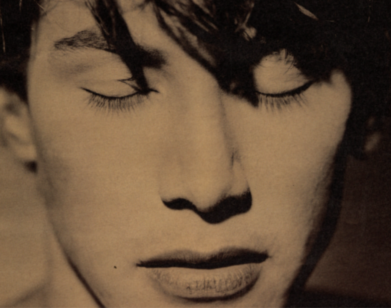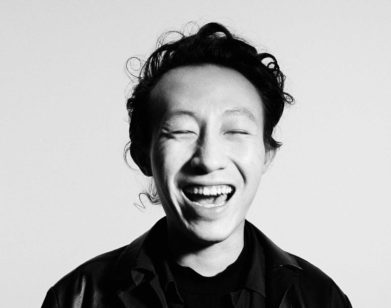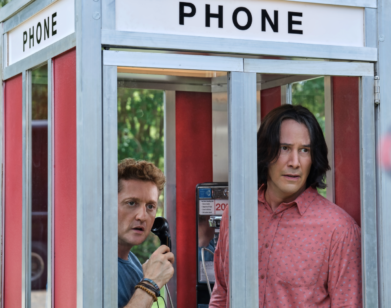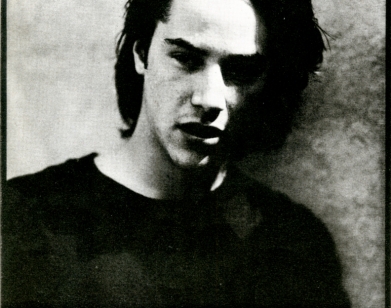ART!
“Euphoric and Grotesque” : Ilana Savdie on Painting Parasites
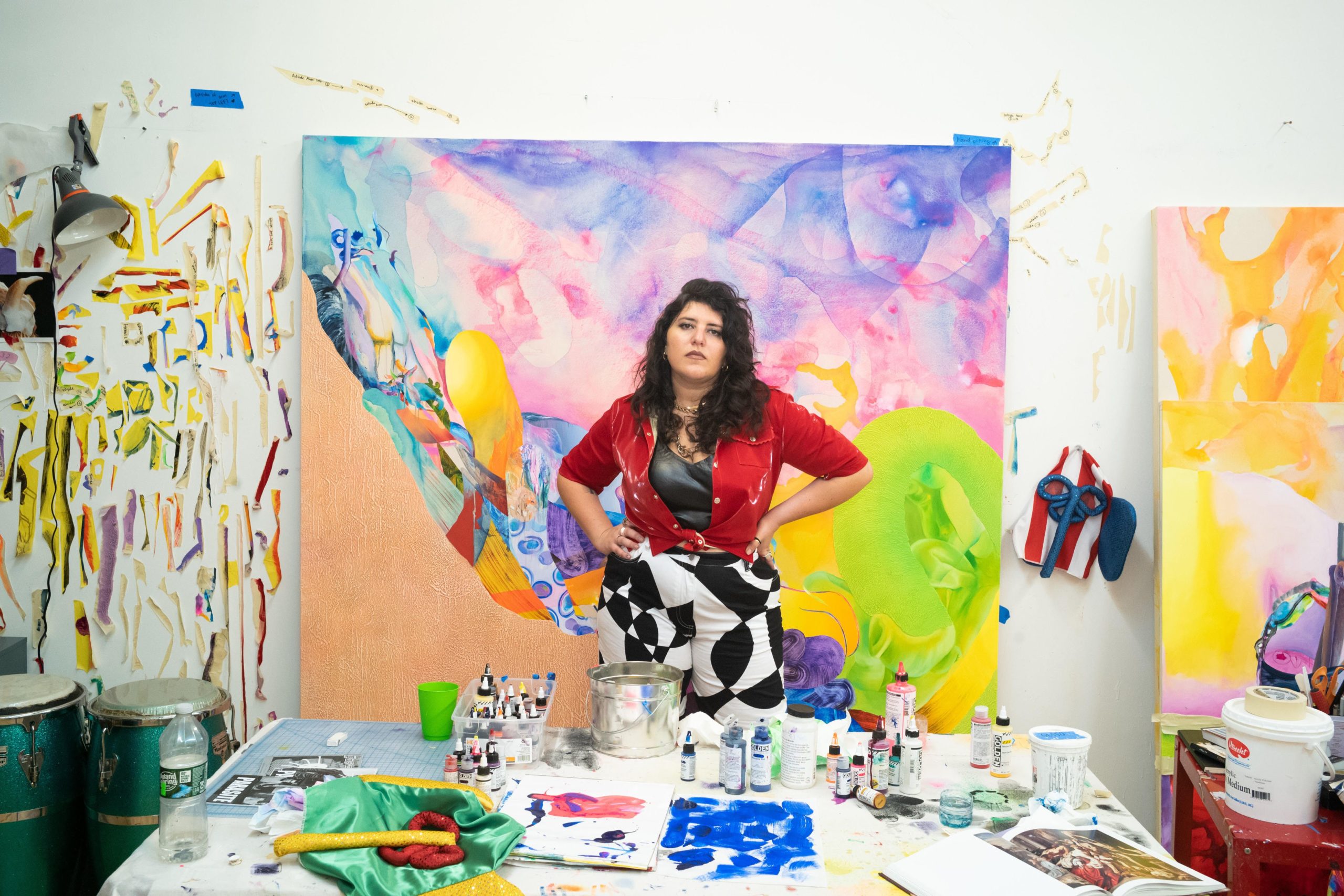
Over the course of her 15-year career, Ilana Savdie has carved out a niche of her own in the contemporary art world with her vibrant, surrealist elaborations on the human form. Her paintings—reminiscent of both the hopeful abstractions of Helen Frankenthaler and the visceral, warped bodies of Francis Bacon—explore the tensions between control and defiance, identity and ambiguity. When it comes to inspiration, Savdie draws heavily on the Carnaval celebration that takes place in her hometown of Barranquilla, Colombia. The week-long festival, which revels in the queer, the exaggerated, and the fantastical, provides an apt lens through which to view the Brooklyn-based artist’s first solo exhibition, Entrañadas. The show features eight large-scale paintings that depict otherworldly human figures against colorful, dream-like landscapes. To celebrate the opening of Entrañadas, on view at Los Angeles’ Kohn Gallery through January 2022, the artist spoke with the curator and activist Jasmine Wahi about painting parasites, her fascination with horror films, and the role of queerness in her work. —SAM FORD
———
JASMINE WAHI: Ilana, let’s just jump into it. I’ve been a fan of your work for a long time. The last time we spoke, I learned about all the values and approaches that we share in the art and cultural space, and that we have similar views on what it means to be a woman of color and a child of immigrants navigating these historically and systemically white spaces. Can you describe for me how your paintings function as performances?
ILANA SAVDIE: I like to think about performance as a focuse on the transformative potential, rather than the fact, of some thing. I think of the body and the spaces we inhabit as stages. I think of the things we consume as performances. If we engage with the world as a series of performances, it gives us a way to dismantle anything that feels too binary or too extreme. When you’re consuming the horrors of the world from a distance via a screen, and simultaneously performing the horrors of the world, the mind starts to blur the two. So there’s this question of sensitivity, insensitivity, de-sensitivity.
WAHI: Because of our overexposure to media, everything now has to have this element of over-drama or melodrama in it for us to understand it as mass communities, otherwise it just tends to fall by the wayside. This leads me to a question about your aesthetics and subjects. When I first encountered your work, I was struck by the maximalist approach to color, lushness, and even texture in the way that you’re laying paint down. It almost has this euphoric quality at first glance, and then, as you start to dig deeper and see these elements of figures or bodies, something starts to emerge that feels dramatic, but also sort of grotesque and otherworldly—dare I say alien. Can you talk a little bit about what these figures are? You refer to them as parasites.
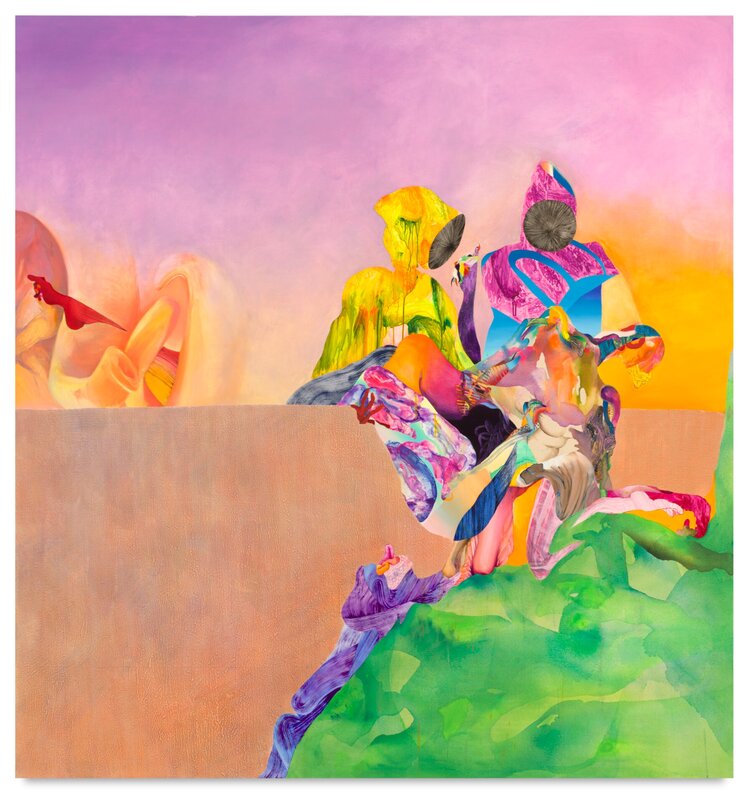
Queen Breeders, 2021, oil, acrylic and beeswax on canvas stretched on panel. Photo courtesy Kohn Gallery.
SAVDIE: It’s definitely both euphoric and grotesque. Color has been this way to work from a place of instinct, rather than thinking too much about the “why.” I root it back to growing up surrounded by the Colombian Carnaval. Queer spaces tend to be extremely colorful. There’s just something about the excess of color that feels like seductive subversion. I think about color as this way of getting to seduce. Once I have you, I can show you a parasite.
WAHI: The old bait and switch.
SAVDIE: Exactly. Getting to infiltrate, penetrate, and contaminate through color feels exciting, powerful, and interesting. And then within that, I like to use as many different sources as I can. I pull from as many different images or models or environments as I can. I juxtapose all these things that feel like they’re not supposed to sit next to each other. They’re using each other as a stage. I’ll use myself as a model, sometimes I’ll use microscopic images of the parasite or the dissection of the human cell or mess with the hierarchy of scale to play with the power dynamic. I’m thinking about all these different ways to amalgamate gesture and color and texture in one plane.
WAHI: Now that you said that, let’s stick with the idea of the parasite for a moment. I don’t want to delve too deeply into the response to COVID because I think that’s sort of a default response. It seems like a natural way to talk about how parasites have entered into the work. But you were using this kind of language pre-pandemic. Do you consider the beings that show up in your work to necessarily be negative, or to be dangerous?
SAVDIE: I think they’re not mutually exclusive and that’s the most important part for me. The idea of the foreign element coming in and invading and imposing is a term that’s been used for people like us, but then it’s also a term that’s been used against people by people seeking a kind of purity. There’s this invention of the binary of positive/negative and good/evil. It becomes an entry point into the dismantling of that. I use violent language and the language of horror because it feels like the grotesque caricature of something. There’s a mockery within that. It’s this thing about access that feels like a way to end the abundance of something, to allow these subjects to take up as much space as possible and then leak into their environment. So there is a clear distinction between the space they inhabit and the cells. There is no clear distinction between the parasite and the host. And then it’s also this way of pointing to the absurdity of invaders calling invaders parasites. Who is the host? And if the host is infected and taken over by the parasite, and the parasite becomes the host, is then that host threatened by another parasite? It just becomes this constant dismantling and that’s where I have a lot of fun.
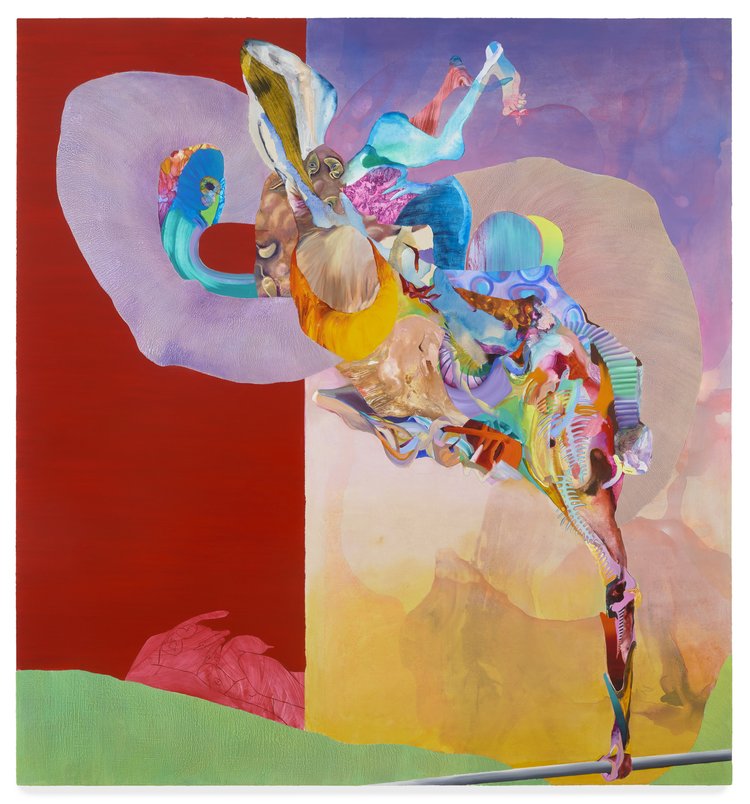
“The Pitch Y Su Torpe Semejanza,” 2021 Oil, acrylic and beeswax on canvas stretched on panel, 72 x 67 inches. Courtesy Kohn Gallery.
WAHI: You use the word “leaking” which is a really good way to describe the aesthetics and messiness. There’s messiness, but also great beauty in the way that things start to blend. It’s a very visceral experience to be in physical concert with the works. Let’s talk about seepage and this type of imagery. The way you’re talking about it in science fiction language. I know that there are certain science fiction ideas, but also films that have been influential in your work. One in particular that comes to mind is The Matrix and that scene, where Neo is being reborn and touches the back of his head and pulls the spike out of his neck. I’m wondering if you can talk a little bit about the horror genre’s influence on your work.
SAVDIE: Scenes, sounds, and moments from different films will stick with me. I arrived at the genre of horror, and specifically body horror, through my work and not the other way around. I was working with some of these visuals that I had in my periphery of pop culture.
WAHI: Osmosis and parasites percolating in your brain.
SAVDIE: Exactly. I haven’t done all the research around horror films the way some people have, and I have a lot of these people as friends, so I would imagine them just cringing at me talking about this from a place of authority. But I respond to the idea of the melodrama of horror and SciFi as an entry point into the aesthetics of excess. With body horror, there’s this sense of gradual transformation of bodies that I think is interesting and feels like a way that I like to play with bodies in my work. There’s this evolution into spaces of another world that can happen through the body, rather than outside of it. The outside and inside can coexist.
WAHI: There’s a morphic element that is very apparent in your work—the ability to morph and expand between two spaces. I think part of your strategy in doing that is incorporating coded visuals and language into the work. So, for example, your titles use Spanglish. What I like about that is that there are certain things in the work that are only meant for certain people. Whereas, if you’re showing in gallery spaces or museums, there’s generally a very predominant demographic audience that may not necessarily be able to appreciate all of the nuances of the work. I think that’s what makes it special. There’s this built-in exclusivity in your work. Can you share a little bit about your approach to code-switching and shape-shifting?
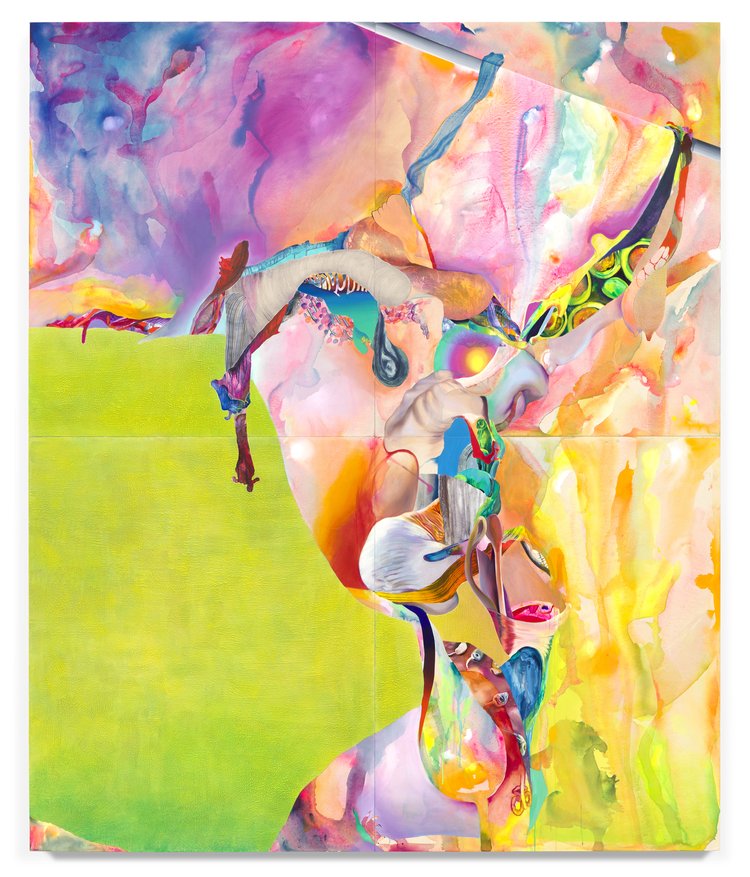
“The Enablers (an adaptation),” 2021 Oil, acrylic, and beeswax on canvas stretched on panel, 4 panels: 60 x 50 inches each, overall: 120 x 100 inches. Courtesy Kohn Gallery.
SAVDIE: I think what we were talking about before with the idea of seducing and tricking, there’s something that I love about getting to seduce someone into looking at a parasite and looking at something that kind of turns them on and then, at the same time, there’s a sense of shame around it. Getting to seduce and repel has a sense of power. Certain people will understand something through the title that other people won’t understand because they have both languages. A term can mean one thing in one language and four things in another. There’s more to give to someone else because they have the privilege of knowing past one thing. I love that I use figures from the Colombian carnival to pull features for a painting. Only people from Colombia know what it is. I love this secret thing that I get to communicate with. In these spaces, people will describe it as a ghostly figure. It’s just really fun to get to penetrate the space. It wasn’t necessarily always invited.
WAHI: Right. At the risk of sharing all the secrets, do you mind sharing a little bit about what these figures are and where they come from?
SAVDIE: The figure is the Marimonda. It’s the party figure. When I did more research, it said that it came from a figure that was meant to mock an oppressive elite in its time. It was a mask made of a monkey and an elephant, combined. It was wearing a suit. I loved the concept of this exaggeration of the body as a form of mockery and mockery as a form of protest. That became interesting to me. I was surrounded by these masks my whole life—fascinated, but also horrified by them.
WAHI: You have a collection right?
SAVDIE: Yeah, whenever someone goes to Barranquilla, I ask for more masks. I have this whole collection of them. It just looks like this human genitalia. Something felt wrong about liking this mask growing up. That had a queer connotation for me. I have a specific relationship to it with my memory of growing up around it and my collection of it, and it also holds this whole cultural significance outside of me, and so that interplay is really interesting to me. It’s a way of talking about memory.
WAHI: When we talked, you mentioned this revelation that not everyone in the world knew what this mask was or what it represented. Was that revelation part of why you decided to incorporate the mask into your work?
SAVDIE: Yes, absolutely. It took me a while to realize that when making this work, it would be something coded. Then it became more about my relationship with it, which opens the conversation to the human condition. I’m using the Carnival as language and as an entry point to turn social norms on their heads and work through the language of excess.
WAHI: I’m hoping you can talk a little bit about the idea of queerness in the work. Do you feel that you are inventing a new aesthetic or language of queerness, or are you pulling from other places and references?
SAVDIE: I don’t think I’m inventing anything. I will respond to a painting in a room that I’ll realize later was a queer artist. Usually, I respond to color, spaces of ambiguity, the uncanny. I’m using language that permeates queer conversation. Watch an episode of Drag Race and you’ll see the same colors. I like to work from a place of instinct, so I don’t always have the language for things that I do. The thing I’ve read the most of is probably performative studies within queer theory. It’s a term that feels like it undoes itself constantly. It has so many conflicting positions and that’s where I think I’m most aligned with it. So it’s the inability to be totally defined.
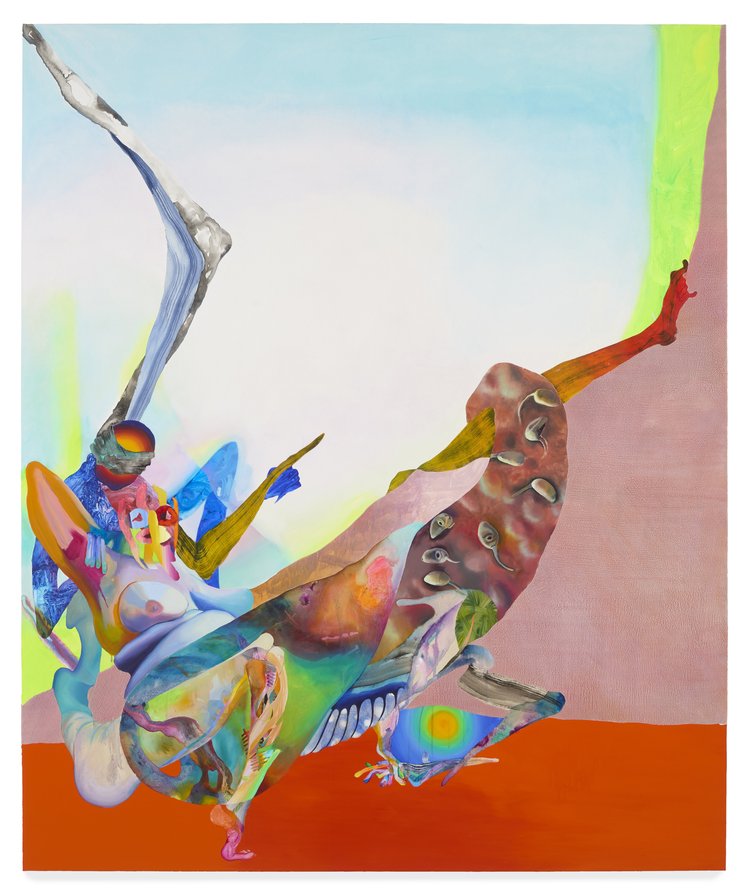
“Lágrimas y mocos (exploiting a suitable host),” 2021 Oil, acrylic and beeswax on canvas stretched on panel, 72 x 60 inches. Courtesy Kohn Gallery.
WAHI: It was an unfair question. You paint from a place of instinct, and it’s almost the antithesis to assert that there is a specific type of queer visual language. You’re working from a place that feels very natural and is in opposition to the rigidity of binary structures. I think that’s what’s so magnificent about it—it’s undefinable. I want to ask about your physical process for painting. I know you mentioned to me that you often end up cannibalizing elements from your work, which, again, is in the language of the grotesque. Can you share a little bit about the process you go through to make a painting?
SAVDIE: I start with a fairly figurative drawing. I look at a lot of religious Baroque paintings.
WAHI: Very dramatic.
SAVDIE: Exactly. I look at these figures when they’re imposing power or binaries. I love starting from that. I’ll start translating those into more and more drawings. I play with different applications of line and paint and mark-making in different ways. That’s when bodies start to dissolve and undo themselves. Then I bring that drawing into digital space and Photoshop. I like to collage that digitally and that’s where I also play with color. I tell you I work from this place of instinct, but there’s a lot of strategizing. I also like to leave a lot of room for play. All these paintings have large sections that have wax-like paint, so there’s this combination of these rigid boundaries and different ways in which I can infiltrate those boundaries. It all becomes leaking, spilling, sagging, or transgressing. All these different terms start to dictate actions of how I apply paint and then respond to how that’s happening. Sometimes even images of my work will go into the collage.
WAHI: That’s where the cannibalizing comes from.
SAVDIE: Yeah. Things get lost in translation and things get gained in translation. I like playing with that as a way of reinventing whatever the original idea was.
WAHI: I just realized I didn’t ask you about the material itself!
SAVDIE: Aside from working with wax, I primarily work with oil and acrylic. From there, I let the material be and seep where it wants to seep and sag where it wants to sag. How does the material change over time? I allow space for that. Where is there an excess of luscious amounts of oil paint that feel like abundance? It’s all of the body, the way painting always feels like it’s of the body. It also reminds me of my own. I like to make large work because I can spread out. I can have shoulders, elbows, and wrists. How do I take up space against this surface? How does this material prevent me from having agency, and how can I exert agency over it? It’s just constant powerplay.

